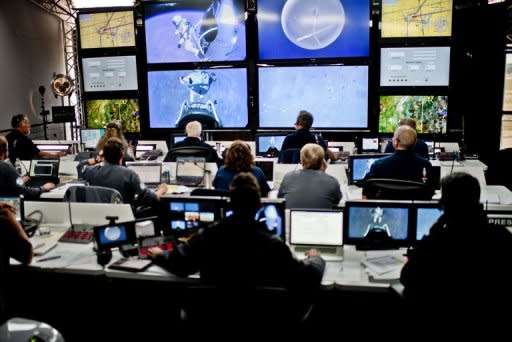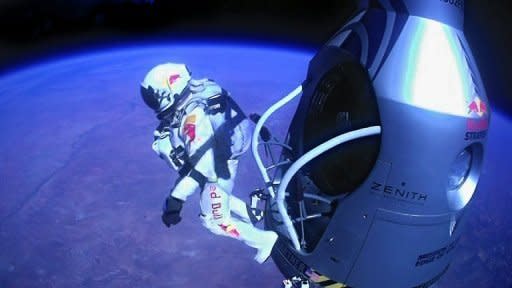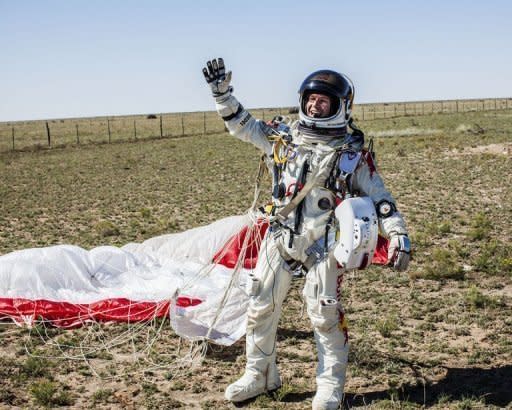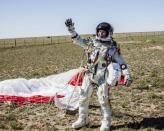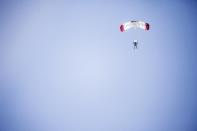Austrian breaks sound barrier in record space jump
Austrian daredevil Felix Baumgartner celebrated his unprecedented feat Monday after becoming the first man to break the sound barrier in a record-shattering, death-defying freefall jump from the edge of space. The 43-year-old leapt from a capsule more than 24 miles (39 kilometers) above the Earth Sunday, reaching a top speed of 833.9 miles (1,342 kilometers) per hour, or 1.24 times the speed of sound, according to organizers. The veteran skydiver was in freefall for four minutes and 20 seconds before opening his red and white parachute and floating down to the desert in the US state of New Mexico, said Red Bull Stratos mission record keeper Brian Utley. Mission control erupted in cheers as Baumgartner sprung from the capsule hoisted aloft by a giant helium-filled balloon to an altitude of 128,097 feet (39,044 meters), even higher than expected. "I think 20 tons have fallen from my shoulders. I prepared for this for seven years," he told German-language ServusTV in Austria in his first interview after the leap. Referring to a helmet problem that nearly forced him to abort at the last minute, Baumgartner said: "Even on a day like this when you start so well, then there's a little glitch. But I finally decided to jump. "It was the right decision," added the Austrian, who broke three records: the highest freefall jump, the fastest freefall speed and the highest balloon flight by a human. He failed to make the longest freefall jump. Shortly before leaping, in footage beamed live around the world on a crackly radio link recalling Neil Armstrong's first words on the Moon, he had said: "Sometimes you have (to go) up really high to (understand) how small you are." After a perfect start, anxious viewers around the world looked on in agony as the Austrian started tumbling chaotically for what seemed like an eternity before finally achieving the correct position. "The exit was perfect, then I started tumbling -- I thought I'd get it under control, but then it really started. I really picked up speed, it got very violent. I thought for a few seconds I'll fall unconscious." "Thank goodness, I managed to stop -- it was very difficult. It was much more difficult than many of us expected." Baumgartner said he wasn't even aware of breaking the sound barrier. "I didn't feel the sonic boom, I think it happens behind you," he said. The Austrian took more than two hours to get up to the jump altitude. Baumgartner had already broken one record before he even leapt: the previous highest altitude for a manned balloon flight was 113,740 feet, set in 1961. He had been due to jump from 120,000 feet, but the balloon went higher than expected. One of the first people to congratulate him was Austrian President Heinz Fischer, who hailed the "great success." "Austria is proud of your accomplishment," he wrote on his Facebook page. Former NASA Astronaut Leroy Chiao, speaking on CNN television, said he believed elements of the pressure suit used by Baumgartner would be "incorporated into future pressure suits that are used in spacecraft." The Red Bull Stratos mission was the second attempt for the skydiver after an initial bid Tuesday was aborted at the last minute due to winds. The biggest risk Baumgartner faced was spinning out of control, which could have exerted excessive g-force and made him lose consciousness. Temperatures of 90 degrees below zero Fahrenheit (minus 68 Celsius) could also have had unpredictable consequences if his suit somehow failed. The helmet problem as Baumgartner ascended added to the sense of alarm: the heater failed on his faceplate, meaning it became fogged up when he exhaled. After considering the options, the nerveless Baumgartner and his entourage decided to go ahead with the jump. Baumgartner's 100-strong backup team includes retired US Air Force colonel Joe Kittinger, who held set the previous highest freefall jump record from 102,800 feet in 1960. Baumgartner holds several previous records, notably with spectacular BASE jumps from the Petronas Towers in Kuala Lumpur and the Christ the Redeemer statue in Rio de Janeiro, Brazil. After Sunday's leap, he recalled the emotions sweeping through his body when he stepped out of the capsule high above Earth. "When you're standing there on top of the world you become so humble... The only thing is you want to come back alive," he told reporters in Roswell, where the launch mission was based. Publicity surrounding the feat made history itself. The mission was recorded by more than two dozen cameras, including one installed on Baumgartner's helmet. It was webcast live on the event website and on YouTube. More than 8 million computers and other digital devices were tuned in to the live stream on YouTube alone, making the jump the most-watched live event ever on the site.



